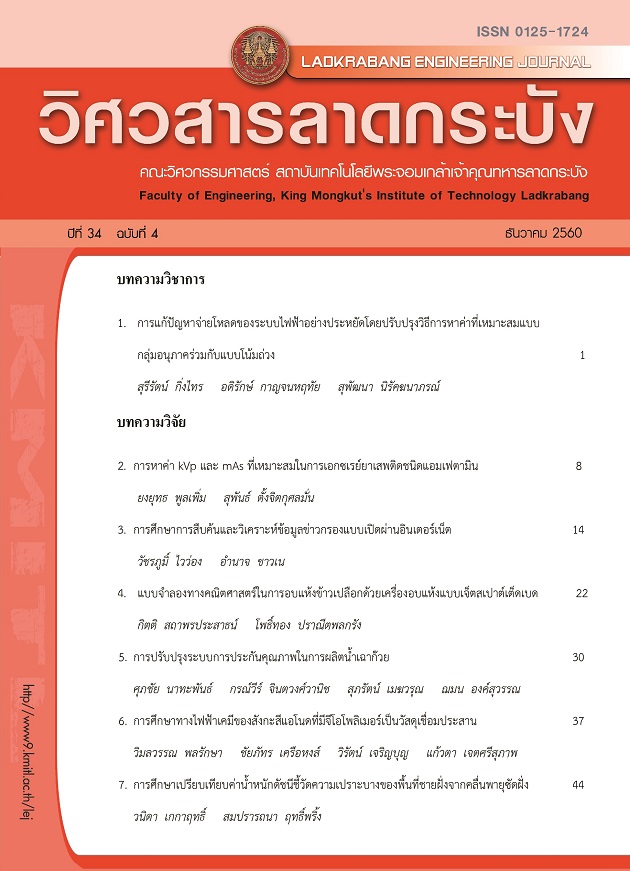Electrochemical Studies of Zinc Anode with Geopolymer Binder
Keywords:
Zinc anode, Geopolymer, Binder, Fly ashAbstract
The electrochemical properties of zinc anode with geopolymer binder have been investigated in this study. The geopolymer binder is composed of fly ash as substrate and sodium silicate (Na2SiO3) together with sodium hydroxide (NaOH) as activator materials. Cyclic voltammetry experiments of the anodes with different geopolymer to zinc ratios (geopolymer : zinc ratios = 32.5 : 6, 32.5 : 9 and 32.5 : 12) were carried out in 4 M NaOH. In the presence of geopolymer binder, the zinc anode did not show any electrochemical characteristics. SEM analysis was carried out to investigate the physical properties of the electrodes. The surface morphology of the anode with the geopolymer to zinc ratio of 32.5 : 12 showed a potential formation of zinc dendrite after 90 cycles.
References
M. Ahmaruzzaman, “A review on the utilization of fly ash,” Progress in Energy and Combustion Science, Vol.36, No.3, pp.327–363, June, 2010.
J. Davidovits, “Global Warming Impact on the Cement and Aggregates Industries,” World Resource Review United State, Vol.6, No.2, pp. 263-278, June, 1994.
A. F. Abdalqader, F. Jin, and A. Al-Tabbaa, “Development of greener alkali-activated cement: utilisation of sodium carbonate for activating slag and fly ash mixtures,” Journal of Cleaner Production, Vol.113, pp.66–75, Feb., 2016.
P. Chindaprasirt, T. Chareerat, and V. Sirivivatnanon, “Workability and strength of coarse high calcium fly ash geopolymer,” Cement and Concrete Composites, Vol.29, No.3, pp.224–229, March, 2007.
K. Andersson, B. Allard, M. Bengtsson, and B. Magnusson, “Chemical composition of cement pore solutions,” Cement and Concrete Research, Vol. 19, No.3, pp.327–332, May, 1989.
S. Hanjitsuwan, S. Hunpratub, P. Thongbai, S. Maensiri, V. Sata, and P. Chindaprasirt, “Effects of NaOH concentrations on physical and electrical properties of high calcium fly ash geopolymer paste,” Cement and Concrete Composites, Vol.45, pp.9–14, Jan., 2014.
C. Sumathi, P. Muthukumaran, S. Radhakrishnan, G. Ravi, and J. Wilson, “Riboflavin detection by α-Fe2O3/MWCNT/AuNPs-based composite and a study of the interaction of riboflavin with DNA,” Royal society of chemistry Advances, Vol.5, pp.17888–17896, Jan., 2015.
Y. Li and H. Dai, “Recent advances in zinc–air batteries,” Chemical Society Reviews, Vol.43, pp.5257–5275, June, 2014.
M. Cai and S.-M. Park, “Spectroelectrochemical Studies on Dissolution and Passivation of Zinc Electrodes in Alkaline Solutions,” Journal of The Electrochemical Society, Vol.143, No.7, pp.2125–2131, Feb., 1996.
M. N. Masri and A. A. Mohamad, “Effect of Adding Carbon Black to a Porous Zinc Anode in a Zinc-Air Battery,” Journal of The Electrochemical Society, Vol.160, No.4, pp.A715–A721, Feb., 2013.
A. R. Mainar et al., “Alkaline aqueous electrolytes for secondary zinc–air batteries: an overview,” International Journal of Energy Research, Vol.40, No.8, pp.1032–1049, Feb., 2016.
Downloads
Published
How to Cite
Issue
Section
License
The published articles are copyrighted by the School of Engineering, King Mongkut's Institute of Technology Ladkrabang.
The statements contained in each article in this academic journal are the personal opinions of each author and are not related to King Mongkut's Institute of Technology Ladkrabang and other faculty members in the institute.
Responsibility for all elements of each article belongs to each author; If there are any mistakes, each author is solely responsible for his own articles.






